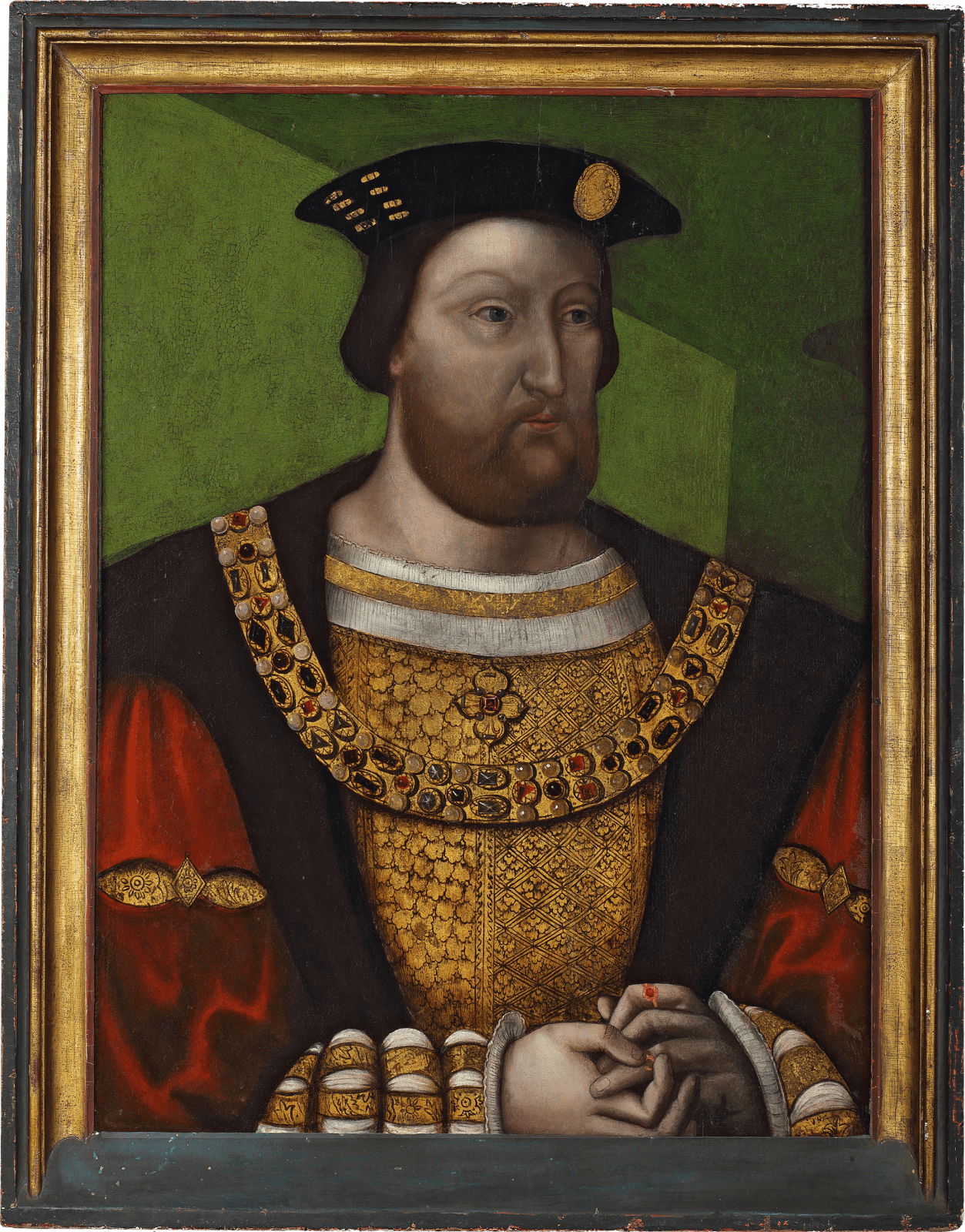
Franco-Netherlandish School
This notable portrait is thought to be one of few surviving panel portraits from the early part of Henry’s reign. Dating to circa 1525-30, chronologically this likeness sits between the portrait by an unknown Anglo-Netherlandish artist, datable to circa 1520[1] and the Joos van Cleve portrait (c.1464-c.1540) of circa 1535.[2] The image also predates Hans Holbein’s (1497/8-1543) universally identifiable portraits of the king, painted from the mid-1530s onwards.[3]
Although it has not been possible to identify the authorship of this portrait, it is likely to have been painted by a Netherlandish artist working under French stylistic influence.[4] The composition of this portrait, depicting Henry in the act of holding or removing a gold ring from his right hand, follows a well-established compositional pattern, which relates to portraits of Henry’s father, Henry VII, painted towards the end of his reign.[5] Echoing this composition, albeit with modifications, reinforced the significance of Henry’s ancestry – a vital component of kingship after the dynastic turbulence of fifteenth-century England.
The large scale of this panel portrait suggests that this was a significant commission.[6] By the mid-1520s, there was a growing requirement for portraits of the king, not least for the purpose of sending abroad to fellow monarchs as diplomatic gifts.[7] In the year 1527, Henry VIII sent portraits of himself and his daughter, the Princess Mary, to Francis I, whose comments upon being shown the portraits were recorded; it is said that he took off his hat and stated that he knew Henry's face well. Early in its history this portrait was altered to represent Francis I. The restructuring of the portrait may have been based on the portrait of Francis, painted circa 1530, by Jean Clouet (active by 1516 – died 1540/41). The two young kings shared many physical similarities that may have confused any early restorer, particularly if the portrait was in France.
Such portrait exchanges during the later 1520s were partially symbolic of the relatively brief rehabilitation of relations between England and France. The year 1520 had seen the ‘Field of the Cloth of Gold’, a show of unity between the two nations played out in the countryside of Calais. Almost a decade later, this portrait may have formed part of the continued power-play between the two young kings, in which portraits as propaganda were recognised as an essential part of the political landscape.
The late 1520s represented an important period in Henry’s life. By 1527, he had begun the process that would eventually annul his marriage to his first wife, Katherine of Aragon, and allow him to marry Anne Boleyn. This led to Henry’s challenge to the power of Pope Julius II and his eventual break with Rome. The present portrait was therefore taken at a most critical point in Henry’s reign. Painted prior to the dominant image that we have of the king, dictated by Holbein’s magnificent likenesses, this portrait presents a fresh face of the young king as slim, sexually magnetic and dynamic.
[1] National Portrait Gallery, London [NPG 4690]. This portrait and the present likeness probably derive from the same prototype but no exact contemporary version of this type appears to have survived.
[2] Royal Collection Trust [RCIN 403368]
[3] Dendrochronology dates the use date of the Baltic oak wood of this panel to between 1511 and 1533. The tree ring sequence of the two Baltic oak panels were dated to end at 1481 and 1503. This dating band was estimated allowing for missing rings and sapwood as well as transportation and manufacture of the panel. (Ian Tyers, Museum of London Archaeology Service, Tree-ring analysis of a panel painting: Henry VIII, 17 July 1995).
[4] Strong, R. (1969) Tudor and Jacobean Portraits. London: Her Majesty's Stationary Office, Vol. 1, p.158. Strong cites specifically the Burgundian school of portraiture, with which this portrait shares strong compositional links.
[5] For an example, see the portrait of Henry VII, Netherlandish School, 1505, National Portrait Gallery [NPG 416], showing the king with his hands to the fore of the image.
[6] Strong, R. (1969) Tudor and Jacobean Portraits. London, Her Majesty's Stationary Office, Vol. 1, p.158 for list of panel portraits from this period, divided into ‘type 1’ (circa 1520) and ‘type 2’ (circa 1527).
An equally early portrait of Henry VIII, probably by a Flemish hand, though of a much smaller size, is in the Fairhaven collection at Anglesey Abbey, Cambridgeshire. The National Portrait Gallery portrait of 1520 [NPG 4690] is also painted on a smaller panel than the present image.
[7] Portraits of Francis I were recorded in the inventories of European rulers, specifically by Henry VIII and Charles II of Spain. The French provenance of the present portrait may also support the theory that it was once a diplomatic gift.
Provenance
Private collection, France;
Weiss Gallery, London, 1995;
Private collection, UK.
- X
- Tumblr
This website uses cookies
This site uses cookies to help make it more useful to you. Please contact us to find out more about our Cookie Policy.
Be the first to hear about our available artworks
* denotes required fields
We will process the personal data you have supplied in accordance with our privacy policy (available on request). You can unsubscribe or change your preferences at any time by clicking the link in our emails.

